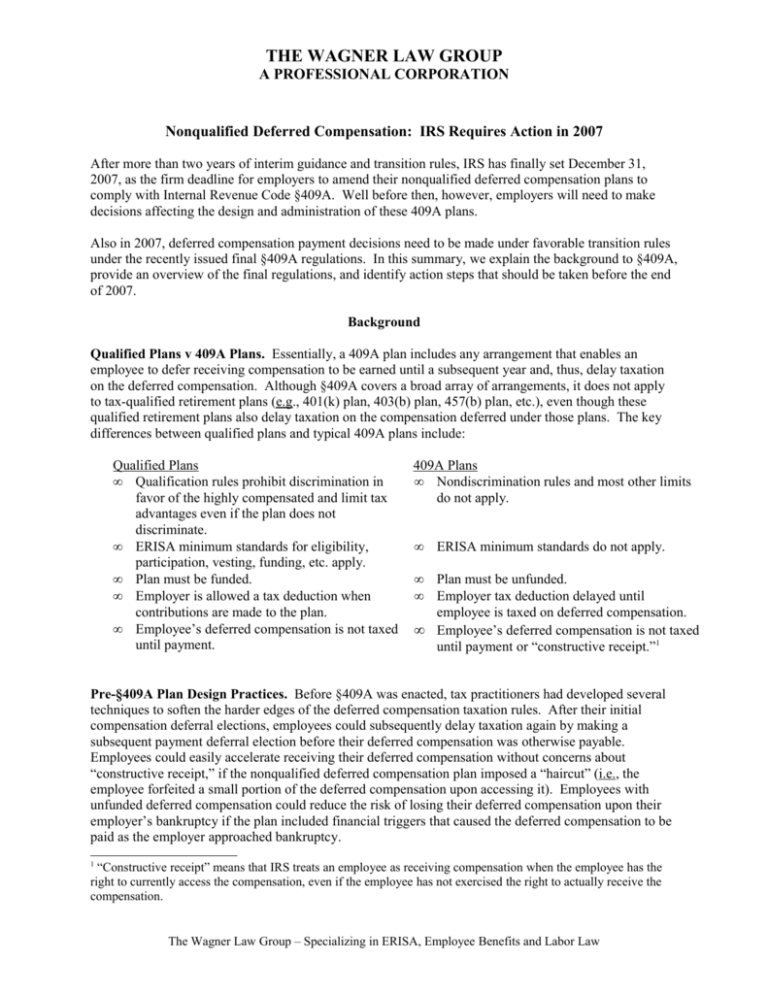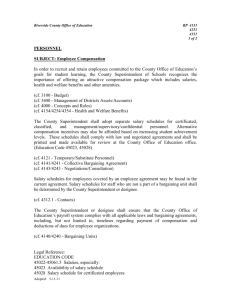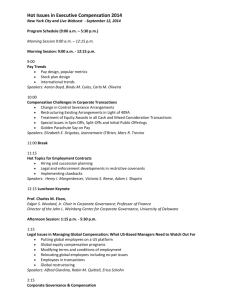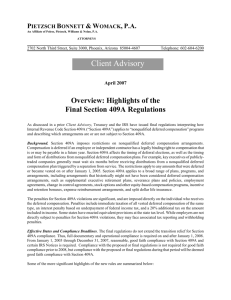Nonqualified Deferred Compensation
advertisement

THE WAGNER LAW GROUP A PROFESSIONAL CORPORATION Nonqualified Deferred Compensation: IRS Requires Action in 2007 After more than two years of interim guidance and transition rules, IRS has finally set December 31, 2007, as the firm deadline for employers to amend their nonqualified deferred compensation plans to comply with Internal Revenue Code §409A. Well before then, however, employers will need to make decisions affecting the design and administration of these 409A plans. Also in 2007, deferred compensation payment decisions need to be made under favorable transition rules under the recently issued final §409A regulations. In this summary, we explain the background to §409A, provide an overview of the final regulations, and identify action steps that should be taken before the end of 2007. Background Qualified Plans v 409A Plans. Essentially, a 409A plan includes any arrangement that enables an employee to defer receiving compensation to be earned until a subsequent year and, thus, delay taxation on the deferred compensation. Although §409A covers a broad array of arrangements, it does not apply to tax-qualified retirement plans (e.g., 401(k) plan, 403(b) plan, 457(b) plan, etc.), even though these qualified retirement plans also delay taxation on the compensation deferred under those plans. The key differences between qualified plans and typical 409A plans include: Qualified Plans • Qualification rules prohibit discrimination in favor of the highly compensated and limit tax advantages even if the plan does not discriminate. • ERISA minimum standards for eligibility, participation, vesting, funding, etc. apply. • Plan must be funded. • Employer is allowed a tax deduction when contributions are made to the plan. • Employee’s deferred compensation is not taxed until payment. 409A Plans • Nondiscrimination rules and most other limits do not apply. • ERISA minimum standards do not apply. • • Plan must be unfunded. Employer tax deduction delayed until employee is taxed on deferred compensation. Employee’s deferred compensation is not taxed until payment or “constructive receipt.”1 • Pre-§409A Plan Design Practices. Before §409A was enacted, tax practitioners had developed several techniques to soften the harder edges of the deferred compensation taxation rules. After their initial compensation deferral elections, employees could subsequently delay taxation again by making a subsequent payment deferral election before their deferred compensation was otherwise payable. Employees could easily accelerate receiving their deferred compensation without concerns about “constructive receipt,” if the nonqualified deferred compensation plan imposed a “haircut” (i.e., the employee forfeited a small portion of the deferred compensation upon accessing it). Employees with unfunded deferred compensation could reduce the risk of losing their deferred compensation upon their employer’s bankruptcy if the plan included financial triggers that caused the deferred compensation to be paid as the employer approached bankruptcy. 1 “Constructive receipt” means that IRS treats an employee as receiving compensation when the employee has the right to currently access the compensation, even if the employee has not exercised the right to actually receive the compensation. The Wagner Law Group – Specializing in ERISA, Employee Benefits and Labor Law Key Concepts in §409A Rules. The American Jobs Protection Act of 2004 added §409A to the Internal Revenue Code to regulate compensation deferral and payment elections. The new §409A rules essentially bar employees from accelerating the payment of deferred compensation. They also restrict the timing of initial compensation deferral elections and subsequent payment deferral elections. The penalties for not complying with these rules are severe. Noncompliance will cause an employee’s deferred compensation (and related investment earnings) to become taxable and subject to a 20% additional tax penalty with a possible assessment of interest. 2007 Action Steps Effective Date. The final §409A regulations are effective January 1, 2008. Plans must operate “in good faith” compliance with §409A and interim guidance from January 1, 2005, through December 31, 2007. Plan amendment deadline. Plan documents must be amended to comply with §409A on or before December 31, 2007. Written plan documents, at a minimum, must include: • Conditions for initial compensation deferral elections, • Amounts being deferred (or the formula for determining amounts deferred), • The time and form of payment (including a six-month delay for payments to key employees of public companies upon employment termination), and • Conditions for subsequent payment deferral elections. The minimum content need not be included in one document. For example, compensation deferral election and payment deferral election forms may be separate from the plan design document. Transition Payment Elections. A §409A plan may allow employees to revise elections as to the time or form of payment of previously deferred compensation, if the revised elections: • are made no later than December 31, 2007, and • do not accelerate deferred compensation payments into 2007 or defer payments otherwise due in 2007 until later years. An employer need not amend its plan retroactively to reflect actions taken during the transitional period (i.e., January 1, 2005, to December 31, 2007), or amend or adopt a written plan document with regard to deferred compensation already paid. Grandfathered Plans. Compensation earned and vested under a nonqualified deferred compensation plan in effect on October 3, 2004, need not comply with §409A. However, if these grandfathered plans are materially modified after October 3, 2004, they become subject to §409A. §409A Overview Compensation Deferral Elections. An employee generally must make a compensation deferral election prior to the year in which the compensation is earned. For example, deferral elections for compensation to be earned in 2008 must be made by December 31, 2007. However, there are many exceptions to the general rule, including the key exceptions described below. Newly Eligible Participants. Employees newly eligible to participate in a 409A plan can make their initial compensation deferral elections within 30 days of becoming eligible. However, the deferral election will apply only to compensation earned after the election. The Wagner Law Group – Specializing in ERISA, Employee Benefits and Labor Law 2 Performance-Based Compensation. Deferral elections for performance-based compensation can be made as late as six months before the end of the performance period. However, the performance period must be at least 12 months. The amount or payment of the compensation must be contingent upon the satisfaction of the performance-based objectives (e.g., bonus tied to achieving sales targets for a year) established at the beginning of the performance period. Also, whether the objectives would be achieved must also be substantially uncertain when they are established. Ad Hoc Bonuses. An employee may elect to defer an ad hoc bonus if: • the employee will forfeit the bonus if he or she terminated employment within 12 months after the bonus is awarded, and • the deferral election is made within 30 days after the bonus is awarded and at least 12 months in advance of the earliest date at which the forfeiture condition could lapse. Excess Plans. Excess plans typically provide benefits based on a formula in a qualified plan that produces benefits that exceed the plan qualification limits designed to restrict benefits for the highly compensated employees. Accruing benefits under excess plans is usually automatic. The design of an excess plan may or may not allow an employee to chose the time and form of payment. The final regulations allow an excess plan to permit employees accruing a benefit to elect the time and form of payment within the first 30 days of the plan year following the year during which they first accrue a benefit. The election applies to benefits that were accrued in the prior plan year as well as those that accrue after the payment election. For purposes of this rule, however, all excess benefit plans are aggregated. Thus, if an employee participates in an excess 401(k) plan, the employee cannot rely on the 30-day special election rule if the employee later accrues a benefit under another excess pension plan. Thus, when an employee first accrues a benefit under any excess plan, the employee should make payment elections for all excess plans under which the employee may accrue a benefit. Payment Elections. When employees make compensation deferral elections under a §409A plan, they must also elect the time and form of payment. Alternatively, the plan must specify the time and form of payment. A §409A plan may allow for payment no earlier than one of the following events: • separation from service,2 • disability,3 • death, • change of control, • unforeseeable emergency, and • at a fixed date or according to a fixed schedule specified by the plan or an employee’s irrevocable election. In certain circumstances, different forms of payment can be elected for different types of payment events. For example, a participant can elect to receive a lump sum payment at disability and installment payments at separation from service. 2 Payment upon separation from service must be delayed at least six months for “specified employees.” These are key employees as defined in the so-called “top-heavy” rules for qualified plans if their employer’s stock is publicly traded. 3 The definition of disability is strict. The employee must be unable to engage in any substantial gainful activity by reason of an impairment that can be expected to last for a continuous period of not less than 12 months or to result in death. Alternatively, the employee must be receiving disability benefits replacing lost wages for a period of not less than three months under the employer’s accident and health plan. The Wagner Law Group – Specializing in ERISA, Employee Benefits and Labor Law 3 Anti-Acceleration Rule. Once an employee or the §409A plan has specified when the deferred compensation will be paid, the payment of the deferred compensation payment cannot be accelerated.4 For example, the §409A regulations would treat the payment of a bonus simultaneously with the employee’s relinquishment of an equivalent amount of deferred compensation under the §409A plan as a prohibited acceleration. Similarly, granting a loan to an employee that is secured by an offset under the §409A plan would also violate the anti-acceleration rule. Beneficiary Payment Elections. The time and form of payment election for death or survivor benefits payable to a beneficiary must generally be made at the same time as the employee's payment election (e.g., whether the employee’s beneficiary will receive a lump sum or an annuity). However, the §409A regulations allow an employee to subsequently change beneficiaries so long as the change does not affect the time or form of payment. Payment Deferral Elections. Changes in payment options must be made at least 12 months prior to the first payment and postpone the first payment a minimum of five years. For example, suppose an employee initially elects to receive deferred compensation in a lump sum at age 65 but now wants to change to installment payments. The employee must make the payment deferral election by age 64 and cannot receive the first installment payment until age 70. A change in the form of a payment from one type of life annuity to another life annuity with the same date for the first annuity payment is not considered a change in the time and form of payment if the annuities are actuarially equivalent. Generally, certain features (e.g., cash refund) are disregarded in determining whether the annuity is a life annuity but not in determining actuarial equivalence. However, the value of a joint and survivor annuity subsidy may be disregarded in determining actuarial equivalence if the amount of annuity, both before and after the first death, does not exceed the amount that would be paid under a single life annuity. §409A Plan Coordination with Qualified Plans. 409A plans are frequently linked to qualified plans. The final regulations continue to allow some coordination but restrict current practices; particularly, in the area of the time and form of payment under the 409A plan. Payment Linkage. Until December 31, 2007, a §409A plan can continue to piggyback on the time and form of payment elections that an employee has made under a qualified plan. As of January 1, 2008, however, direct linkage of the time and form of payments between a qualified plan and a §409A plan is no longer permitted. With a proper plan design, however, excess defined benefit 409A plans are still permissible under the final regulations. Amount Linkage. An employee can increase or decrease elective deferrals (and other employee pre-tax contributions) under qualified plans up to the 401(k) salary reduction limit ($15,500 for 2007, plus where applicable the catch-up limit) without regard to the §409A rules. However, elective deferrals (or other pre-tax contributions) made under a qualified plan that cause decreases or increases in the amount of deferred compensation under a 409A plan in excess of the salary reduction limit must conform to the §409A compensation deferral and anti-acceleration rules. Funding Restrictions. An employer maintaining a 409A plan cannot fund a 409A plan for the top five officers (or certain other key employees) while any qualified defined benefit plan is in “at-risk” status because it is poorly funded or while the employer is in bankruptcy. The funding restriction also applies six months before or after an underfunded qualified defined benefit plan is terminated. The 409A plan 4 Payments made on separation from service, disability, death, change of control, etc. would not violate the antiacceleration rule if the §409A plan provided for payments upon the occurrence of these events. The Wagner Law Group – Specializing in ERISA, Employee Benefits and Labor Law 4 funding restriction applies even to amounts set aside in a so-called “rabbi trust” whose assets remain subject to the employer’s creditors in bankruptcy. Plan Terminations. Employers can terminate a 409A plan without adverse tax consequences under §409A if: • the plan termination is not proximate to a downturn in the employer’s financial health, • the employer terminates all other similar 409A plans, • payments under the plan are made no earlier than 12 months, and no later than 24 months, after the employer takes the necessary steps to terminate the plan, and • the employer does not adopt another similar 409A plan for three years. Split Dollar Illustration. An equity split-dollar arrangement is subject to §409A if the employee earns a right to cash value that is payable in a later year. However, the §409A compensation deferral election rules are usually not relevant because employers typically make nonelective premium payments to the insurer. On the other hand, the §409A anti-acceleration rule and the restrictions on changing the time and form of payment could come into play. For example, the anti-acceleration rule could be problematic if an employee could borrow the cash value from the insurance policy before employment termination. Short-Term Deferral Exception. The §409A regulations carve out so-called “short-term deferral” arrangements. Essentially, §409A does not apply to deferred compensation that is paid within 2 ½ months after the employee’s or employer’s tax year in which the deferred compensation is earned or, if later, becomes vested. Future Guidance. The Treasury Department and IRS will issue guidance in the future on various §409A issues including, W-2 reporting, the 20% additional tax penalty for §409A violations, and funding restrictions. C:\Documents and Settings\len\Local Settings\Application Data\Opera\Opera\temporary_downloads\Nonqualified Deferred Compensation. IRS Requires Action (A0010537).DOC The Wagner Law Group – Specializing in ERISA, Employee Benefits and Labor Law 5







